Street Art Speaks: A Conversation with Mural Artist & Activist LMNOPi
This is the first of a new series that I am doing called Street Art Speaks. I am kicking it off with an interview with mural artist LMNOPi. She is one of my favorite mural artists in New York. Her work conveys a humanity and intimacy that I find very touching. I wanted to have a conversation with her about street murals and asked her if she would respond to some questions. Below are her thoughts on a wide range of issues: a humanistic vision, being a woman mural artist, gentrification, engaging the community in the creation of street art, the tagging of street murals. It is a very meaningful statement about street art and the community.
I know that you are a political progressive (occupy wall street, immigration murals and posters, etc.). Why is it important to you to express a progressive vision in your street art?
I don’t actually ascribe to the label of “progressive”. I find labels to be problematic. If pressed, however, I would say I am a humanist, if anything, and as such I paint about issues concerning the rights of humans. I consider it my duty to utilize the tools at my hands to amplify voices from communities who are on the frontlines of the numerous crises we face as a people in this day and age. What other choice do I have than to use the gifts I was given in this way? My aim is to use my art to raise awareness as well as to reflect back to people their own struggles in a way that will hopefully be fortifying. To let them know they are seen; especially for the kids. My message is one of resilience, strength & perseverance. I want to say to them You are loved, keep going.
Does being a women influence you as a street artist? For instance, does it impact on what you and how you paint? What about the culture of street artists? Some places I’ve been there are almost no women and others there are a lot. Any thoughts on this would be helpful.
At my core, I think of myself as ‘me’ not as a gender or category. However, being a woman in the street art world can be a challenge. In my experience, the art world in general (and street art is no different) is male dominated. I am heartened to see more and more women bursting forth with so much talent that they cannot be ignored. I am always happy to see my sisters succeed.
There are some extremely talented and visionary women artists out there! More than people realize. What bothers me at times is when I suspect tokenism to be at play instead of a real desire to give exposure to gifted women artists. It bothers me because when a woman becomes a token, she is low hanging fruit and becomes the go-to when curators are looking for women artists to add to their roster. Instead of doing the work of really searching for talent that is more obscure and could actually use the support, they give that platform to women who already have an enormous platform. I say, share the stage; let us all rise together.
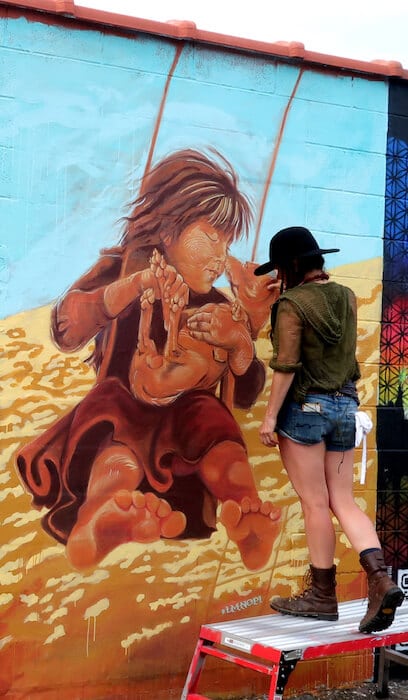
When you see a lot of women street artists together, it is likely that the curator is a woman and is purposefully promoting women centric shows.
As far as how my womanhood influences subject matter, I freely admit that I very rarely paint men. I almost exclusively will paint women and children. We have enough images of men being glorified, they don’t need a larger megaphone.
Bushwick and other areas in NYC are being gentrified. Some people think that street art leads to gentrification. What do you think?
When one talks about “street art” it is important to differentiate. Public art is what I call sanctioned murals which are done with permission and hopefully they pay the artists for their labor because it’s hard work. Muralists are in a difficult spot. We have to be careful who we paint for and why. We should slow down and consider who is benefiting from our labor.
When artists come in from other places to paint walls in neighborhoods around the country like Bushwick and do not take the time to learn about the communities that live there, it becomes more of an outdoor gallery serving a clientele of tourists, real estate agents and property owners. It becomes more about elevating one’s own fame and bringing in dollars for those entities. It has the effect where it hollows out a neighborhood; makes it more of a destination than an actual community. The people who have lived there and have grown up there likely become alienated by some of the art.
It’s best practice for the artist to do due diligence and take a look at the demographics before painting something. To consider how their imagery will effect the kids who are growing up there. To play to that audience. To work to inspire that audience. Those families are the ones who are then priced out because now it’s a hip place to live. They’re getting the short end of the stick, so to speak, when the wave of upper class people who want to have that urban experience move in. Those same people would never have chosen to live there before the murals were there. These murals are more like advertisements than anything. Advertising a way of life, advertising a neighborhood to appeal to a larger audience that can be charged higher rents.
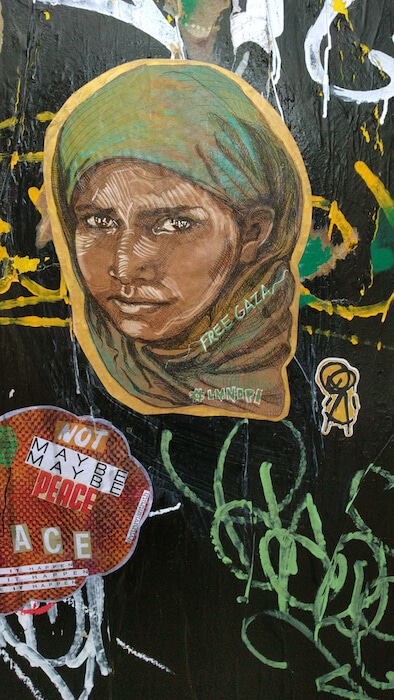
Adding to this is the other trend of certain media businesses who are riding on the popularity of murals to paint actual advertisements so that it’s becoming more and more difficult to tell the difference. On one hand I admire the skill of the artists that are hand painting these massive advertisements and I like that they are bringing the craft of sign painting back, but on the other hand I really resent the way our world is permeated with commercials for products to the point where you can’t look anywhere and not see something trying to sell you something. But that is capitalism, which in my opinion is the root of all of our problems. If it weren’t for capitalism, what gifts would those working artists bring forth for the world to enjoy instead of grinding away, painting ads.
My definition of street art encompasses “unsanctioned” artwork; this runs that gamut from stickers to tags to graffiti to wheatpastes and also other creative public interventions. This type of street art I think is like the neighborhood’s wild life. The messages & imagery is not moderated. People can say whatever they want, paint whatever they want. The grungier the better. What is more beautiful that a door that has layers and layers of stickers and tags and wheatpastes? It’s a conversation. It’s the commons being reclaimed. I think most landlords would see that type of art as undesirable because it hurts their profit margin. Whatever hurts their profit is probably logical karma in action being aided by some of us out here. This kind of street art is not pushing gentrification, in my opinion.
I want to add on here the proposition that when done right, mural art can be a community raising tool. It really depends on the intentions of the artist and how they approach their work. Murals can beautify and uplift a community if the community is included in the design, if they are given a voice in what they will see everyday. If not, then it’s just another form of occupation.
It’s a treacherous terrain we trod as muralists. It’s a huge responsibility and I think it is important for us to navigate this terrain with as much integrity we can muster. If you really want to know the answer to this question, however, I would urge you to go interview people who are long time residents in any of those neighborhoods. I’d be interested in hearing their perspective. Me? I am biased. I love art, especially street art. When i travel through a city that has no graffiti it feels soulless. It feels spooky when a city is too clean.
Graffiti and tagging vs. street art. One of your murals (the Earth Revolution in Bushwick was tagged). I heard that you added the word evolve to the mural after it was tagged. Is this true? Why did you do that? What do you think about the issue of street art murals being tagged?
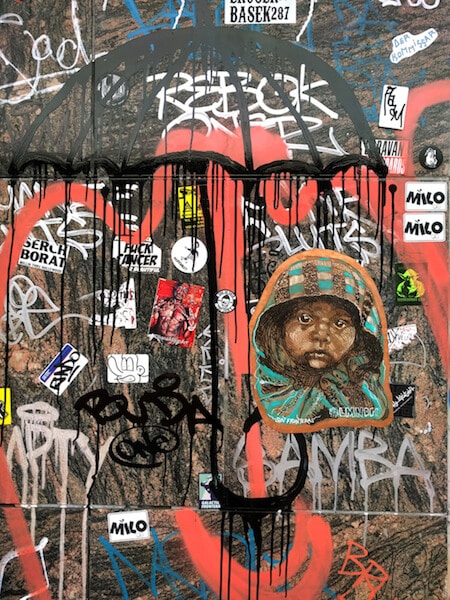
Yes, the Earth Revolution mural was attacked during a rampage by one graf writer who did throwies on a bunch of the Bushwick collective murals. He positioned himself as a champion against gentrification and against the BC murals; claiming he grew up in Bushwick. We found out later that he is really from the Bronx. His stance was that he was against outsiders coming in to paint “his” neighborhood. I understand his message and I actually agree with it to a certain extent. However, two things: one: he hit the wrong mural when he hit mine. If he wants to talk about outsiders; he should think a little deeper before hitting a portrait of an Indigenous Youth Activist. I’m just saying.
Also, that mural has zero to do with the Bushwick Collective. I was hired by the building owner to paint her wall. The guy positioned himself as an underdog or a champion of the marginalized. As a white man he chose to vandalize a mural painted by a female street artist of a young woman of color. His posturing kind of falls flat in my opinion.
As I am a local Brooklyn resident, I came back to fix it immediately. Back channel he was trolling me on instagram, calling me an “art fag” which I found to be not offensive. I was like, yeah, I am a fag. And? His whole demeanor was homophobic and aggressively male, which kind of tipped me off of the likelihood that his rampage was more about getting fame than protesting gentrification. I obviously don’t know because I am not in the guy’s head but what was obvious was that he needed to evolve past homophobia so I decided to paint that word there as a gentle suggestion to him and a general exhortation to the entire world.
What do I think about murals being tagged? I think it’s part of the gestalt of making work in public. If artists don’t want to be tagged, they should put their work in a museum. I think sometimes tags make a mural more attractive. Currently, the evolve mural is pretty tagged up. I go back from time to time and just put them into the background and refresh but I don’t buff out the tags altogether unless they go right over her face or the message. I will likely go refresh it again soon. I like the way it looks with all the tags in the background. It’s a great example of how things evolve over time, so in that way it’s pretty meta.
Some people are concerned that international street artists are flown in to paint while local artists are ignored. Is this your experience? What do you think about that?
I think there needs to be a balance. If you are going to fly international artists in to paint; match it with local artists. For every out of towner, pick a local. If there are not enough local artists, match the internationals with local youth; pay them to be assistants so they can get inspired to pick up the craft themselves. Foster your community, germinate it, water it and sit back and watch it grow. Bringing in international artists is a great thing to do and can be very inspiring for people who live there if it is done with integrity.
Where you can see LMNOPi’s work
I’d like to hear your thoughts and responses to Street Art and this conversation. Please leave a comment or a question.
Please Pin and Share
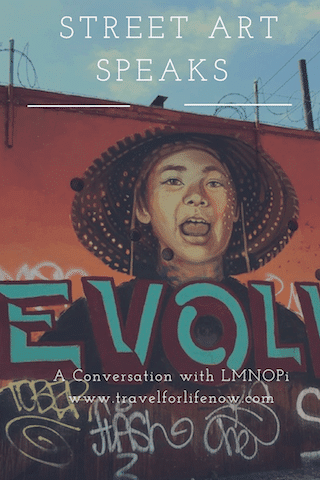

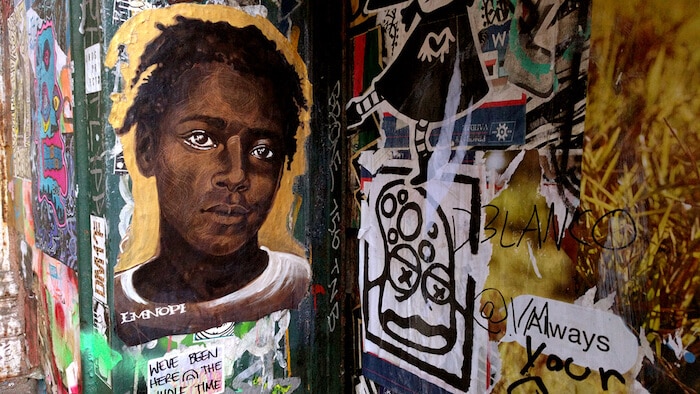
What an interesting interview! Street Art Speaks is really a great series and I look forward to the next interview
Glad you enjoyed it. If you follow me then you’ll get the next one automatically
How interesting! I love checking out street art around Sydney. And as you see more of it, you become familiar with different artists’ styles. It would be fascinating to chat to the artist whose murals you enjoy.
Yes. Me too. I love wandering and discovering. Looking to do more of these interviews.
Mural artists are so talented! What an interesting series.
Thanks. I look forward to publishing more in this series.
Thanks!
Her art is simply amazing, so stunning, I wished I had such incredible talent. Loving the interview style of article, thanks for sharing!
Thank you Odette. Glad to hear that you love her work. I love it too.
Sue – This is a fabulous new series. I’m a fan of street art and love your approach of interviewing the street artists. I agree with LMNOPi that if a city doesn’t have street art it “feels soulless.” Look forward to reading more!
Thanks so much for your comments. I’m working on the next one already.
It’s so interesting to learn a bit about the street art from inside rather then just seeing it and making up your own stories and assumptions. I love the self-definition of “humanist” – something I can definitely relate to!
We love street art, and I love that you are bringing it to life even more with this series. What a powerful idea to allow everyone to hear the story behind the art. Thank you and I’ll definitely be following along!
That’s a great post! Such a unique topic. We often snap selfies in front of street art and never once think about the stories behind the paintings and the artists. Thanks for sharing.
I love street art, it is always so interesting to walk around and see for yourself, especially many artists have a great and powerful message 🙂
Nice to see your post
Thank
So interesting! And I love the art! Thanks for sharing!
Thanks. Glad you loved it
I had no idea that street art had become so mainstream. It seems a shame in a way to see what I think of as a rebellion turned into a way to increase the value of a neighbourhood. I am glad the artist considers the people that live where she paints and I hope there are many artists that still are considered rebels that paint outside of the lines.
There are certainly artists who paint outside of the lines and others that straddle them. And some of it is very mainstream now. It’s all very conflicting.
What an incredible fascinating woman and I really appreciate her senseblities in terms of her outlook on artists, feminism and her all boats rise together philosophy – wish there was more of that in this world.
Yes. I was impressed with her responses.
I enjoyed reading this interview, and I look forward to the next in the series. I love finding street art when I’m traveling, so I really liked hearing the perspective of an artist.